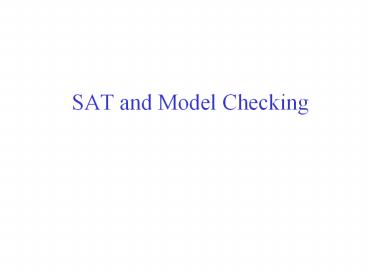SAT and Model Checking - PowerPoint PPT Presentation
Title:
SAT and Model Checking
Description:
Verification: can we find a counterexample in k steps ? Biere, Cimatti, Clarke, Zhu, 1999 ... Given a propositional formula in CNF, find if there exists an ... – PowerPoint PPT presentation
Number of Views:38
Avg rating:3.0/5.0
Title: SAT and Model Checking
1
SAT and Model Checking
2
Bounded Model Checking (BMC)
Biere, Cimatti, Clarke, Zhu, 1999
- A.I. Planning problems can we reach a desired
state in k steps? - Verification of safety properties can we find a
bad state in k steps? - Verification can we find a counterexample in k
steps ?
3
What is SAT?
Given a propositional formula in CNF, find if
there exists an assignment to Boolean variables
that makes the formula true
literals
?1 (b c) ?2 (?a ?d) ?3 (?b d) ?
?1 ?2 ?3 A a0, b1, c0, d1
clauses
SATisfying assignment!
4
BMC idea
Given transition system M, temporal logic
formula f, and user-supplied time
bound k
Construct propositional formula W(k) that is
satisfiable iff f is valid along a path of length
k
Path of length k
Say f EF p and k 2, then
What if f AG p ?
5
BMC idea (contd)
AG p means p must hold in every state along any
path of length k
We take
So
That means we look for counterexamples
6
Safety-checking as BMC
p is preserved up to k-th transition iff W(k) is
unsatisfiable
If satisfiable, satisfying assignment gives
counterexample to the safety property.
7
Example a two bit counter
Initial state
Transition
Safety property AG
W(2) is unsatisfiable. W(3) is satisfiable.
8
Example another counter
Liveness property AF
Check EG
where
W(2) is satisfiable
Satisfying assignment gives counterexample to the
liveness property
9
What BMC with SAT Can Do
- All LTL
- ACTL and ECTL
- In principle, all CTL and even mu-calculus
- efficient universal quantifier elimination or
fixpoint computation is an active area of research
10
How big should k be?
- For every model M and LTL property ? there exists
k s.t. - The minimal such k is the Completeness Threshold
(CT)
11
How big should k be?
- Diameter d longest shortest path from an
initial state to any other reachable state. - Recurrence Diameter rd longest loop-free path.
- rd d
rd 3
12
How big should k be?
- Theorem for Gp properties CT d
13
How big should k be?
- Theorem for Fp properties CT rd
- Open Problem The value of CT for general Linear
Temporal Logic properties is unknown
14
A basic SAT solver
- Given ? in CNF (x,y,z),(-x,y),(-y,z),(-x,-y,-z)
?
Decide()
Deduce()
X
?
Resolve_Conflict()
X
X
X
X
15
Basic Algorithm
Choose the next variable and value. Return False
if all variables are assigned
While (true) if (!Decide()) return (SAT)
while (!Deduce()) if (!Resolve_Conflict())
return (UNSAT)
Apply unit clause rule. Return False if reached
a conflict
Backtrack until no conflict. Return False if
impossible
16
DPLL-style SAT solvers
SATO,GRASP,CHAFF,BERKMIN
A Æ
empty clause?
y
UNSAT
n
conflict?
Obtain conflict clause and backtrack
y
n
is A total?
y
Branch add some literal to A
SAT
17
The Implication Graph
(Øa Ú b) Ù (Øb Ú c Ú d)
Assignment a Ù b Ù Øc Ù d
18
Resolution
a Ú b Ú Øc
Øa Ú Øc Ú d
b Ú Øc Ú d
When a conflict occurs, the implication graph
is used to guide the resolution of clauses, so
that the same conflict will not occur again.
19
Conflict clauses
(Øa Ú b) Ù (Øb Ú c Ú d) Ù (Øb Ú Ø d)
d
Assignment a Ù b Ù Øc Ù d
20
Conflict Clauses (cont.)
- Conflict clauses
- Are generated by resolution
- Are implied by existing clauses
- Are in conflict with the current assignment
- Are safely added to the clause set
Many heuristics are available for
determining when to terminate the resolution
process.
21
Generating refutations
- Refutation a proof of the null clause
- Record a DAG containing all resolution steps
performed during conflict clause generation. - When null clause is generated, we can extract a
proof of the null clause as a resolution DAG.
Original clauses
Derived clauses
Null clause
22
Unbounded Model Checking
- A variety of methods to exploit SAT and BMC for
unbounded model checking - Completeness Threshold
- k - induction
- Abstraction (refutation proofs useful here)
- Exact and over-approximate image computations
(refutation proofs useful here) - Use of Craig interpolation
23
Conclusions BDDs vs. SAT
- Many models that cannot be solved by BDD symbolic
model checkers, can be solved with an optimized
SAT Bounded Model Checker. - The reverse is true as well.
- BMC with SAT is faster at finding shallow errors
and giving short counterexamples. - BDD-based procedures are better at proving
absence of errors.
24
Acknowledgements
Exploiting SAT Solvers in Unbounded Model
Checking by K. McMillan, tutorial presented at
CAV03 Tuning SAT-checkers for Bounded Model
Checking and Heuristics for Efficient SAT
solving by O. Strichman Slides originally
prepared for 2108 by Mihaela Gheorghiu.































